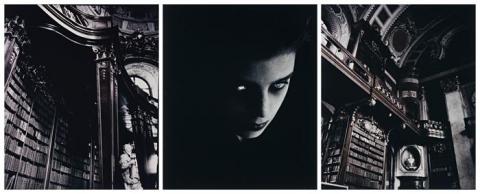UNTITLED (TRIPTYCH) 1983/84, 1983-84
Bill Henson
Type C photograph
77.0 x 65.0 cm (each)
signed, dated and inscribed below images
Roslyn Oxley9 Gallery, Sydney
Private collection, Victoria
'In 1970, Eric Smith's portrait of architect Neville Gruzman won the Archibald Prize for portraiture in Australia. It's a confronting image. Gruzman's penetrating eyes stare out and upward from the canvas... Gruzman is in a short-sleeved shirt. There are no indications here to tell us that Gruzman is an architect, no Renaissance hand on the plan with the other hand holding a pencil or pen, no buildings in the background. It's him, just the person. Smith's portrait is direct, almost confronting. This person speaks his mind. But its frankness belies Gruzman the architect, the man always in a suit and whose buildings are complex, unusual, difficult to categorise, intensely personal, serene, shimmering and reflective. 'Oh but that's what Neville is really like,' many people would say. His work, like his personality, is at once chimerical, brilliant, outspoken and assertive. You cannot divorce the two.'1
The work of Neville Gruzman occupies a unique space in the development of postwar architecture in Australia. Dramatic and distinctive, Gruzman's principals were founded in the modernist, organic wake of Frank Lloyd Wright where form and function are one; the building itself a sculpture in which one lives. Very much a Sydney architect, the shores of our glittering harbor are dotted with many of Gruzman's elegant and idiosyncratic designs which speak to a myriad of international sources whilst never abandoning their particular sense of place.
Originating as tributes in the early 1950s to Wright and Mies van der Rohe, Gruzman's houses were to be forever changed by his visit to Japan in the mid '50s. Each project was now informed by a new sensitivity, beautifully captured in the Goodman House, Middle Cove (1956-57) and transformed once more in his own home on Oswald Street, Darling Point. Underpinned by the Japanese awareness of 'the rituals of entry, the importance of the threshold, and the significance of landscape elements'2, the Gruzman house explores and transforms Wrightian notions of spatial compression. To enter the house one must first navigate a tight wooden spiral stair, hung for many years with Olsen's majestic tapestry Joie de Vivre which features in this sale, before emerging into a minimal and serene living room which would later earn the admiration of Danish architect Jørn Utzon.
Despite maintaining a busy architectural practice, Gruzman was also for a time a Professor of Architecture at The University of New South Wales, and the Mayor of Woollahra. In 1984 he was awarded the Order of Australia for his contributions to Australian architecture and for many years an active member and eventual board member of the National Trust of Australia. The works from his collection which are being offered in this auction reflect a man of particular sensibilities; complex, brilliant and without compromise.
1. Goad, P., Gruzman: An Architect and His City, Craftsman House, Sydney, 2006, p. 17
2. ibid., p. 23
